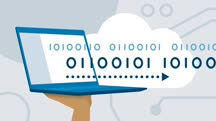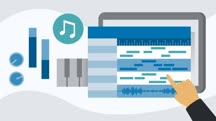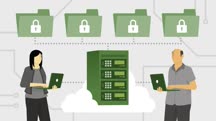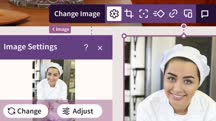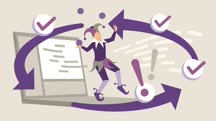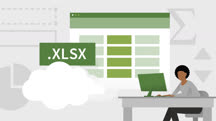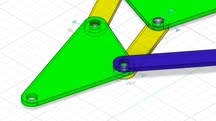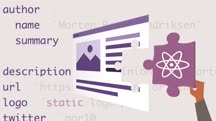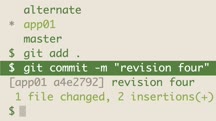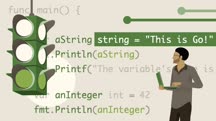Course catalog
Categories
Showing 781-800 of 1,450 items.
Learning Cloud Computing: Serverless Computing (221626)
Serverless computing allows you to build and run applications and services without having to manage infrastructure. This course is targeted at IT professionals who need to gain a foundational knowledge of serverless computing—what it is and why it's important—and what's offered by serverless computing technologies like AWS Lambda and Azure Functions. Instructor David Linthicum begins with the basics: what serverless computing is and the problems it can solve. He then explores effective use cases for serverless computing and runs through demos of both AWS Lambda and Azure Functions.
Learning Cloud Computing: The Cloud and DevOps (233084)
Move DevOps to the cloud and become more agile at software development and operations. This course explains how to set up a cloud-based DevOps process and leverage services offered by Amazon and Microsoft. Cloud computing expert David Linthicum first introduces the business case for DevOps in the cloud, which can ensure scalable and continuous delivery, testing, integration, and deployment for organizations of any size. He then explains how to establish a DevOps process on the cloud, and reviews DevOps solutions offered in Amazon Web Services and Microsoft Azure. Plus, review some use cases that demo real-world implementations of DevOps services on the cloud.
Learning COBIT (221524)
The COBIT framework offers a tailored approach to creating a governance and management framework for enterprise information and technology systems. It helps balance value and compliance—aligning the business and IT so that everyone is working towards the same goals. Learn the basics of COBIT and what it can do for your organization, as well as some tips for achieving COBIT certification, in this course with IT consultant and trainer Mark Thomas. Mark covers the principles, concepts, and key components of the latest version of the framework, COBIT 2019, and provides practical advice on how to adopt and adapt COBIT to your unique organization. Using this guide, you will be able to understand the features and benefits of the framework and begin the process of adoption, from designing a tailored governance system to measuring its performance. Along the way, you can explore the various training and certification paths in the COBIT portfolio.
Learning Computer Security and Internet Safety (217869)
Learn how to safeguard your computer, keep your digital data secure, and protect your privacy online. This beginner's guide to cybersecurity, concentrating on Windows, will help you prevent malware, viruses, and security breaches on your computer and your network. First, instructor Jess Stratton guides you through securing your computer or laptop—using built-in tools such as Windows Defender, firewalls, and encryption—and protecting your wireless network. Then, see how to adjust privacy and security settings in your web browser, avoid phishing scams, use public Wi-Fi safely, and enable two-step verification for more secure logins. Finally, learn how to bolster your online privacy and protect friends and family by obscuring sensitive information in photos and emails. By the end of this course, you'll know how to secure your computer and keep your information safe online.
Learning Conversion Copywriting (217291)
Conversion copywriting teaches you how to write compelling marketing copy that converts online prospects to customers. This course walks you through all the basic steps of conversion copywriting. Instructor Joanna Wiebe begins by teaching you how to think about conversion rate optimization from a strategic perspective, and then goes into the three steps of the conversion copywriting process. Joanna teaches you how to borrow messages from customers, including how to define, find, and research the voice of the customer (VOC). She explains how to find the what and how in your VOC, then what to do with your VOC. Next, she takes you through how to use proven frameworks to organize messages on a page, as well as how to write a first draft for web and email copy. Once your first draft is complete, Joanna shows you how to use copywriting formulas to increase the persuasive power of your headlines. Plus, learn how to make conversion copywriting an ongoing practice.
Learning Creative Cloud Libraries (224057)
Creative Cloud Libraries allow you to access your assets anywhere—from any device. This course shows how to collect and organize images, colors, text styles, and other elements created in various Creative Cloud desktop and mobile apps into CC Libraries, and share those assets between applications. Learn about the CC ecosystem and the libraries in Photoshop, InDesign, After Effects, Animate, Capture, Dimension, and more. Plus, discover how to share and search libraries and use libraries as a collaboration tool for your whole design team.
Learning Cubasis (225502)
Do you want to learn more about Cubasis, the app for producing music on your iOS or Android device? In this course, instructor Mark Struthers gives an overview of Cubasis' powerful audio and MIDI features and walks you through the workflows needed to create, perform, record, and mix music. Mark shows you how a project is constructed in terms of the Cubasis UI and walks you through several useful project options. He points out some things to be aware of when you create new projects. Mark steps through some of the editors and effects that you can use, including how to access third-party AU effects. He shows you how to use EQ to achieve a clearer mix and goes over group tracks, the mixer, and automation. Mark concludes with a discussion of creative functions that you can find in Cubasis.
Note: This course was created by Mark Struthers. We are pleased to host this training in our library.
Note: This course was created by Mark Struthers. We are pleased to host this training in our library.
Learning Data Analytics Part 2: Extending and Applying Core Knowledge (215591)
It’s one thing to work with data. It’s another to provide quality data sets and accurate visualizations for decisions to be made. If you are considering a course emphasis or a career in data analytics, this course can help you get off to a good start. Robin Hunt, CEO and co-founder of ThinkData Solutions, shares practical skills to help you get the most from your data and jumpstart your career in data. Robin discusses business rules, filtering out the noise in the data we all deal with, and how to deliver what decision-makers want. She covers how to create data sets with queries, joins, and appends, then goes into building aggregate data with total queries. Robin goes over pivots, how to use pivots to build basic dashboards and visualizations, and how to use Power Query for data transformations. She concludes with best practices for meetings and taking your work to the next level for your organization.
Learning Data Analytics: 1 Foundations (210576)
Are you interested in pursuing a career in data analytics? In this course, instructor Robin Hunt brings you into the mind of an analyst. She defines and explains foundational concepts, such as how to think about data, how to work with others in different roles to get the data you need, and the tools you need to work with data, such as Excel and Microsoft Access. She introduces you to SQL queries, PowerBI, and more. Robin goes into syntax and explains how to interpret the data you see, find the data you need, and clean the data for effective data work. She explains data governance and how to ask the right questions of different departments to gather the data you need. Robin shows how to work with data, including how to import data, work with flat files such as CSVs, and create datasets for others. Robin goes into what cleaning and modeling mean, as well as how to use Power Query in Excel. She has also added challenge/solution sets in each chapter to help you evaluate your skills.
Learning Data Governance (218923)
In the era of big data and data science, data governance has the ability to help all types of organizations and individuals become more successful. In this course, Dr. Jonathan Reichental introduces the topic of data governance in terms that everyone can understand, and helps you discover why your organization may benefit from data governance, how it's implemented, and why it is essential in compliance and risk reduction efforts. Jonathan also covers the role of data governance in emerging technology areas such as knowledge graphs, artificial intelligence, and the Internet of Things. In the last part of the course, he shares ideas on how organizations should think about managing, monitoring, and measuring data governance efforts. As data science grows in its importance in the 21st century, so does the demand for data governance expertise. Start here for your first look at this in-demand skill.
Learning Design Thinking (223462)
Learn how to take a human-centered approach to design by exploring the methodology known as design thinking. In this course, Randall Elliott explains how design thinking is used to empathize, define, ideate, prototype, test, and refine. He covers what the purpose of each phase is and how to apply it to your planning and design processes. He also shares examples and practical uses of the underlying concepts. By the end of this course, you will be equipped with methods you can implement to uncover the needs of your customers, define findings, derive insights, and create innovative solutions.
Learning DriveWorksXpress (225553)
Do you want to use the popular free DriveWorksXpress SOLIDWORKS add-on? In this course, design engineer Ryan Krawchuk shows you how to create user interfaces for customizing the parameters of your models, so that you can easily generate new versions without the usual complexity. Ryan introduces you to the DriveWorksXpress interface and walks you through creating new projects and capturing several different types of SOLIDWORKS files. He explains how to use the DriveWorksXpress form to create text boxes, spin buttons, drop-down boxes, and more. Ryan covers rules for SOLIDWORKS part dimensions and features, then concludes with clear instructions on how to run a test generation to see if your project is working correctly.
Learning Editor X (226267)
Today's content management systems are easier to use than ever before. So what does it mean to have an ultra-flexible CMS that isn't too technically difficult to use? In this course, instructor Jen Kramer explains the Editor X workflows and workspace, including how to create and edit content and how to build and publish websites. Jen shows you how to create a project and choose a template, walks you through the interface, and describes how to use the theme manager to configure colors and type. She covers how to add a logo, customize your page’s navigation, and add a variety of features to your page. Jen steps through reordering sections of your page and building additional pages. She concludes with an explanation of how to launch your Editor X site.
Learning End-to-End Testing with Jest (234818)
Testing small parts of an application is fairly easy, but as you assemble systems, the test complexity often grows with the number of interconnected systems. Sometimes, rather than testing just the parts, you want to test the whole process, as one large set. In this course, Chinyelu Ibute shows you how the JavaScript testing framework, Jest, lets you create comprehensive tests so you can verify the functionality of your entire application. Chinyelu starts with the basics of the test-driven development, including the different types. She then shows how to write an end-to-end test for a RESTful web-service application built with Node.js and MongoDB using Jest. Finally, she explains how to test the application workflow from beginning to end, with a high code coverage.
Learning Excel Desktop (Office 365/Microsoft 365) (2018) (227236)
Looking to get started with Microsoft Excel? This beginner-level course can help. Join instructor David Rivers as he introduces new users to the fundamentals of Excel. David covers how to create new workbooks, add and format numbers and text, work with basic formulas and functions, and leverage key features such as AutoFill, which allows you to quickly fill new cells using existing cells where there is a pattern. Plus, learn how to insert charts, quickly share your spreadsheets with others, and more.
Learning Fresco (224958)
Learn how to use Fresco, the pressure-sensitive drawing and painting app from Adobe that is designed to be used with stylus and touch devices. Instructor Kyle Webster begins with the basics of how to use Fresco including customizing the interface. He explains technical components of the program such as locating recent documents, saving files, and exporting your work, and dives into more artistic aspects including how to use tools to achieve looks including watercolor, oil, pencils, and mixed media.
Learning Fusion 360 (222986)
Learn how to use Autodesk Fusion 360, the cloud-based 3D computer-aided design (CAD), computer-aided manufacturing (CAM), and computer-aided engineering (CAE) application that unifies design, engineering, and manufacturing into a single platform.
Instructor Taylor Hokanson gives an overview of the interface, then walks through the modeling, sculpting, and rendering workflows in Fusion 360. Taylor also shows how to import reference images, use the sketching tools, extrude 3D shapes, combine components into assemblies, and render animations that show designs in action. Plus, learn how to sculpt organic shapes by editing T-spline forms.
Instructor Taylor Hokanson gives an overview of the interface, then walks through the modeling, sculpting, and rendering workflows in Fusion 360. Taylor also shows how to import reference images, use the sketching tools, extrude 3D shapes, combine components into assemblies, and render animations that show designs in action. Plus, learn how to sculpt organic shapes by editing T-spline forms.
Learning Gatsby (234274)
Gatsby is a modern take on the static site generator. Built on React, it uses GraphQL to extract information from data sources such as WordPress. Learn how to use this flexible JavaScript framework to build performance-focused websites in this course with Morten Rand-Hendriksen. Discover how to get Gatsby up and running and use the starter projects to quickly build out your sites. Find out how to work with Gatsby pages, assets, and components, and style your sites using multiple CSS approaches: standard static style sheets, inline styles, CSS modules, styled components, and more. Plus, learn how to extend Gatsby with plugins, connect to data sources with GraphQL queries, create pages dynamically using transformer plugins and Node.js scripts, and get your Gatsby site ready for production.
Learning Git and GitHub (218957)
Version Control lets you manage changes you've made to files over time, and is an essential skill for developers to master. Git is by far the most popular version control system on the web. In this fast-paced course, Ray Villalobos shows you the fundamental commands that you need to work with most Git projects. He explains how to use checkpoints called commits, which let you leave messages documenting what happened at each checkpoint, as well as how to create branches that are alternate versions of your project that you can work on without changing the original. Plus, he shows how to work with the popular GitHub website to explore existing projects, clone them to your local hard drive, and use them as templates for your new projects.
Learning Go (220776)
What is Go? Go is a next-generation, open-source programming language created by Google for building systems, web, and other applications. This course is designed to help developers get started with Go, covering its core language elements and syntax. David Gassner introduces tools and skills used in a Go workflow—including Go Playground, an online tool that takes Go development off the desktop. He also covers basic programming tasks: managing values, using math operators, storing values as complex types, and managing program flow. Plus, learn how to create reusable Go code, read and write files, and make simple web requests.
